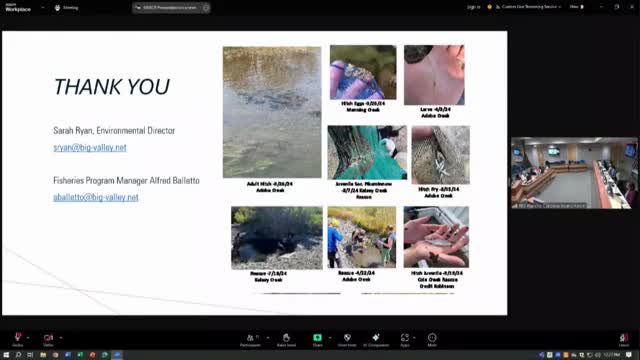Central Valley Water Board tackles harmful algal blooms and supports Big Valley tribes
December 23, 2024 | State Water Resources Control Board, Agencies under Office of the Governor, Executive, California
This article was created by AI summarizing key points discussed. AI makes mistakes, so for full details and context, please refer to the video of the full meeting. Please report any errors so we can fix them. Report an error »

The State Water Resources Control Board meeting on December 18, 2024, spotlighted critical water quality challenges affecting the hitch fish population in California. Erin Bender, a senior scientist with the Division of Water Rights, presented findings that underscore the complexity of these issues, particularly the role of harmful algal blooms in the lake's ecosystem.
Bender highlighted that while external factors contribute to water quality problems, internal conditions—such as low dissolved oxygen levels and water column mixing—are significant drivers of harmful algal blooms. This revelation points to the need for a multifaceted approach to managing water quality. The Central Valley Regional Water Board is actively addressing these challenges through various initiatives, including a nutrient Total Maximum Daily Load (TMDL) management program and collaboration with local tribes on harmful algal bloom sampling.
The next steps involve genetic typing of cyanobacteria to better understand the specific types contributing to these blooms, alongside pilot studies to evaluate potential management strategies. Additionally, the board is exploring options for streamflow augmentation to assist in fish rescue efforts during dry periods, ensuring that property owners can release water into streams when needed.
The meeting also touched on ongoing coordination with the Department of Toxic Substances Control and the Environmental Protection Agency regarding the Sulfur Bank Mercury Mine, indicating a comprehensive approach to water management and environmental protection.
As the board continues to tackle these pressing issues, the implications for both local ecosystems and agricultural partners remain significant, highlighting the interconnectedness of water quality and wildlife survival in California.
Bender highlighted that while external factors contribute to water quality problems, internal conditions—such as low dissolved oxygen levels and water column mixing—are significant drivers of harmful algal blooms. This revelation points to the need for a multifaceted approach to managing water quality. The Central Valley Regional Water Board is actively addressing these challenges through various initiatives, including a nutrient Total Maximum Daily Load (TMDL) management program and collaboration with local tribes on harmful algal bloom sampling.
The next steps involve genetic typing of cyanobacteria to better understand the specific types contributing to these blooms, alongside pilot studies to evaluate potential management strategies. Additionally, the board is exploring options for streamflow augmentation to assist in fish rescue efforts during dry periods, ensuring that property owners can release water into streams when needed.
The meeting also touched on ongoing coordination with the Department of Toxic Substances Control and the Environmental Protection Agency regarding the Sulfur Bank Mercury Mine, indicating a comprehensive approach to water management and environmental protection.
As the board continues to tackle these pressing issues, the implications for both local ecosystems and agricultural partners remain significant, highlighting the interconnectedness of water quality and wildlife survival in California.
View full meeting
This article is based on a recent meeting—watch the full video and explore the complete transcript for deeper insights into the discussion.
View full meeting
